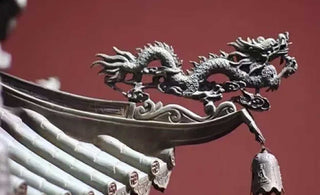
In the realm of art, the interplay between tradition and innovation has always been a captivating source of inspiration. As we delve into the dynamic world of contemporary art, we find echoes of Oriental art movements breathing new life into the creative landscape. Drawing from the rich heritage of the East, artists today are reimagining and reviving traditions in mesmerizing and inventive ways. This article explores the captivating journey of how Oriental art movements continue to shape and influence contemporary artistic expressions.
1. The Resurgence of Ink Wash Painting:
Ink wash painting, known as Sumi-e in Japan and Shui-mo-hua in China, has witnessed a remarkable resurgence in contemporary art practices. This traditional medium, rooted in ancient techniques and philosophies, is undergoing a transformative evolution as artists infuse it with a modern twist. With their experimentation with unconventional materials and exploration of new subject matters, these artists are creating captivating pieces that bridge the gap between the past and the present.
The delicate black lines and vibrant washes of ink, hallmark elements of ink wash painting, continue to evoke a sense of harmony and tranquility. However, contemporary artists are pushing the boundaries of this traditional medium, challenging conventional notions and redefining its possibilities. By incorporating mixed media, such as collage, digital elements, or even unconventional materials like coffee or wine, they breathe new life into the essence of ink wash painting. These innovative approaches allow for a fusion of traditional techniques with contemporary aesthetics, resulting in visually striking and conceptually engaging artworks.
Moreover, contemporary ink wash artists are also exploring new subject matters, expanding beyond the traditional landscapes, flora, and fauna. They delve into social, cultural, and personal narratives, addressing contemporary issues and conveying their unique perspectives through the poetic language of ink wash. This infusion of new themes and ideas adds a fresh dimension to the art form, making it relevant and relatable to today's audiences.
Through their innovative approach, these artists pay homage to the legacy of ink wash painting while simultaneously pushing its boundaries. They celebrate the rich heritage and aesthetic principles of this ancient art form while embracing the freedom to experiment and reinterpret its essence. This dynamic interplay between tradition and innovation not only revitalizes ink wash painting but also establishes a dialogue between the past and the present, creating a bridge that connects generations of artists and viewers.
2.The Allure of Ukiyo-e:
Ukiyo-e, the captivating woodblock print tradition originating in Japan, continues to find its contemporary voice in the modern art scene. This traditional art form, known for its narrative storytelling and vivid colors, has become a source of inspiration for artists who seek to reinvent and revitalize it. By infusing Ukiyo-e with contemporary themes and aesthetics, these artists create a dialogue that bridges the gap between tradition and modern life.
Incorporating elements of popular culture and social commentary, contemporary Ukiyo-e artists invite viewers to explore the intersection between the past and the present. They delve into contemporary issues, capturing the spirit of the times and reflecting on the complexities of modern society. Through their reinterpretation of Ukiyo-e, these artists infuse the art form with new layers of meaning and relevance, offering a fresh perspective that resonates with contemporary audiences.
The allure of Ukiyo-e lies in its ability to transcend time, captivating audiences with its timeless beauty. The intricate woodblock printing techniques, the vibrant colors, and the narrative storytelling transport viewers to a world that is both familiar and otherworldly. The evocative imagery and symbolic representations in Ukiyo-e prints continue to speak to the human experience, transcending cultural boundaries and resonating with viewers across generations.
By engaging with Ukiyo-e in a contemporary context, artists pay homage to its historical significance while breathing new life into its aesthetic and thematic elements. This fusion of tradition and modernity creates a dynamic and captivating artistic landscape that celebrates the enduring legacy of Ukiyo-e while presenting it in a fresh and compelling way.
3. Calligraphy: Beyond the Written Word:
Calligraphy, renowned for its elegance and artistic discipline, extends its influence far beyond mere words on paper. Contemporary artists are redefining calligraphy by breaking free from the confines of traditional characters and exploring new forms of expression. The graceful brushwork and expressive strokes of calligraphic art become abstract representations of emotions and concepts. By embracing the inherent aesthetics of calligraphy while pushing the boundaries of conventional forms, these artists revitalize this ancient practice and transform it into a captivating visual experience.
4. The Zen Aesthetic:
The Zen philosophy deeply influenced various Oriental art movements, such as the simplicity enshrined in the Edo period's Rinpa school or the Taoist principles reflected in Chinese literati art. In contemporary art, the Zen aesthetic continues to inspire artists, urging them to embrace minimalism, tranquility, and mindful presence. Through the use of empty space, exquisite craftsmanship, and poetic compositions, artists create immersive experiences that invite viewers to contemplate the essence of existence. The echoes of Zen allow for a deeper connection with the art, evoking a sense of calm introspection amidst the chaos of the modern world.
Conclusion:
As we witness the revival of traditions through the lens of Oriental art movements, it becomes evident that these artistic legacies continue to captivate and inspire. The contemporary echoes of ink wash painting, Ukiyo-e, calligraphy, and the Zen aesthetic highlight the vitality of artistic evolution and the power of cross-cultural dialogue. By embracing the past while pushing the boundaries of artistic expression, modern artists pay homage to tradition while creating a profound impact on the artistic landscape. Let us celebrate this vibrant blend of heritage and innovation, cherishing and encouraging the continuous revival of Oriental art movements.
























